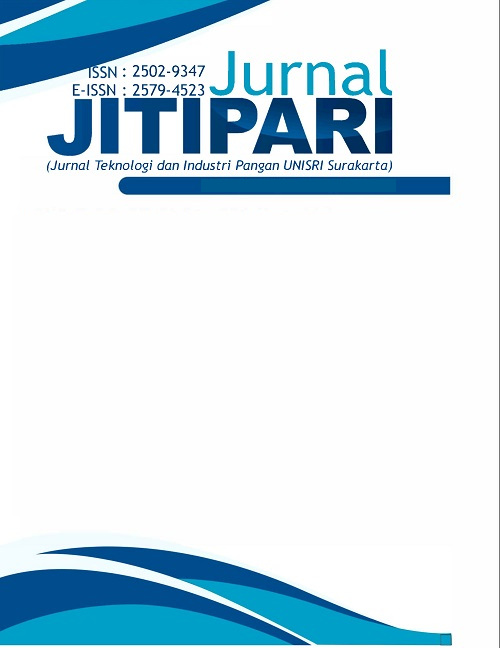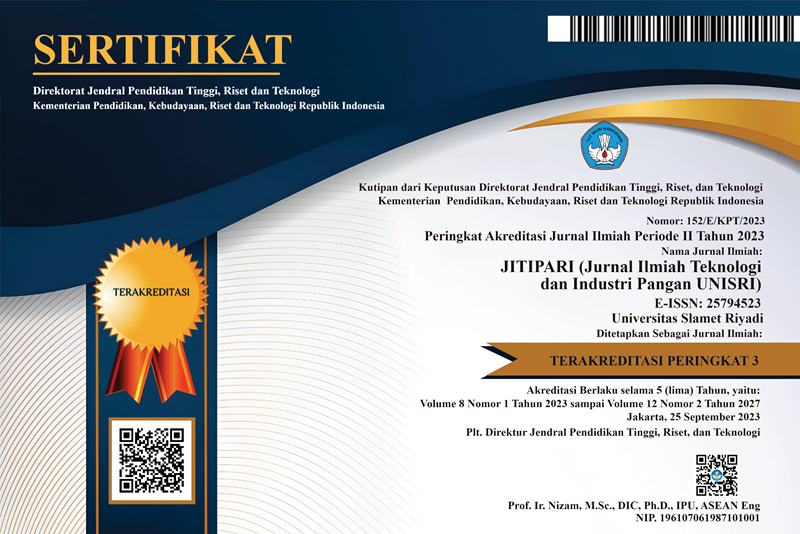The Effectiveness of Edible Coating Aloe Vera (Aloe vera chinensis L.) in Inhibiting Enzymatic Browning on Sliced Apples
DOI:
https://doi.org/10.33061/jitipari.v8i2.7338Abstract
Apple is a fruit that turn brown quickly after being cut. One method to maintain the quality of apples cut is coating the fresh-cut apples with an edible coating. Ediblei coatingi is a thini ilayer that can bei eaten and can keep the iquality ofi the icoated material. Thei study aimed toi determinei the effectiveness of edible coating aloe vera (Aloe vera chinensis L.) in inhibit enzymatic browning reaction. The designii wasi usiing icompletely irandomized idesign. The first factor was the citrus species (Citrus aurantifolia, Citrus hystrix DC, Citrus amblycarpa) iand the secondi factori was thei istorage itime (0, 3, 6 day). Edible coating applied to fresh-cut apples and tested for moisture content, total dissolved solids, weight loss, color, overall appearance, vitamin C and total plate count. Thei resultsi ishowed that aloe vera edible coating with citrus extract was not effective in inhibiting the enzymatic reaction of sliced apples. The type of citrus and storage time was affect the effectiveness of aloe vera edible coating. Citrus amblycarpa extract has a lower water content reduction effect with a water content of 54.51% on the 6th day of storage time and has an effect on the total plate count, that Citrus amblycarpa extract has decreased total plate count in day 6th. Citrus aurantifolia extract gives the effect of maintaining brightness compared to other types of citrus, with a brightness value of 58,290 on the 6th day. The type of citrus has no effect on weight loss, total dissolved solids, overall appearance. The length of storage has an effect on the effectiveness of aloe vera edible coating, the longer it is stored, the apples cut will decrease in quality.
References
Alim, L. B., Purwijantiningsih, L. M. E., & Pranata, F. S. (2016). Aplikasi edible coating dari pati tapioka dan air perasan jeruk nipis (Citrus aurantifolia) pada bakso. Jurnal Publikasi.
Alsuhendra, Ridawati, & Santoso, A. I. (2011). Pengaruh penggunaan edible coating terhadap susut bobot, pH dan karakteristik organoleptik buah potong pada penyajian hidangan dessert. Introduction to Soil Microbiology. 2nd Edition, 1.
AOAC. (1984). Standard Official Methods of Analysis of the Association of Analytical Chemists (14th ed.). S.W Williams.
Asmal, A. (2018). Analisis kandungan vitamin C dalam cabai rawit (Capsicum fructuscens. L). Farmasi Sandi Karsa, 4(7), 99–103.
Association of Official Analytical Chemist. (1990). Official Methods of Analysis. AOAC international.
Budiman. (2011). Aplikasi pati singkong sebagai bahan baku edible coatingg untuk memperpanjang umur simpan pisang cavendish ( Musa cavendishii .). Institut Pertanian Bogor.
Demasta, E. K., Al-Baarri, A. N., & Legowo, A. M. (2020). Studi perubahan warna pada buah apel (Malus domestica Borkh.) dengan perlakuan asam hipoiodous (HIO). Jurnal Teknologi Pangan, 4(2), 145–148.
Gardjito, M., & Wardana, A. S. (2003). Hortikultura Teknik Analisis Pasca Panen. Transmedia Mitra Printika.
Hadiwijaya, Y., Kusumiyati, & Munawar, A. A. (2012). Prediksi total padatan terlarut buah melon golden menggunakan vis-swnirs dan analisi multivariat. Jurnal Penelitian Saintek, 25(2), 3–10.
Haq, G. I., Permanasari, A., & Sholihin, H. (2010). Efektivitas penggunaan sari buah jeruk nipis terhadap ketahanan nasi. Jurnal Sains Dan Teknologi Kimia, 1(1).
Hilmi, M. Z., Swastawati, F., & Anggo, A. D. (2017). Pengaruh perendaman berbagai jenis jeruk terhadap kandungan logam berat timbal (Pb) dan kromium (Cr) pada kerang hijau (perna viridis Linn). Jurnal Pengetahuan & Biotek Hasil Pertanian, 6(2).
Huse, A. M., Wignyanto, & Dewi, I. A. (2014). Aplikasi edible coating dari karagenan dan gliserol untuk mengurangi penurunan kerusakan apel romebeauty. Fakultas Teknologi Pertanian Universitas Brawijaya, 1–10.
Inggrid, H. M., & Iskandar, A. R. (2016). Pengaruh pH dan temperatur pada ekstraksi antioksidan dan zat warna buah stroberi. Prosiding Seminar Nasional Teknik Kimia, 1–7.
Inggrid, M., & Soebandy, W. P. (2019). Penghambatan browning pada ekstrak apel Malang dengan asam organik. Prosiding Seminar Nasional Teknik Kimia Kejuangan, April, E8-2.
Jibril, N. M. (2018). Studi aktivitas enzim polifenol oksidase ( PPO ) dari buah langsat ( Lansium parasiticum ). In Universitas Hasanuddin: Makassar. Universitas Hasanuddin.
Maajid, L. A., Sunarmi, & Kirwanto, A. (2018). Pengaruh lama penyimpanan terhadap kadar vitamin C buah apel ( Malus sylvestris Mill.). Jurnal Kebidanan Dan Kesehatan Tradisional, 3, 90–94.
Maghfiroh, J., Sofa, A. D., Aprilia, A., & Affandi, A. R. (2018). Efektivitas penambahan kitosan dan ekstrak jeruk nipis dalam pembuatan antimicrobial edible coating dan aplikasinya pada fresh-cut jambu kristal. Jurnal Ilmu Pangan Dan Hasil Pertanian, 2(1), 82–90.
Mardiana, K. (2008). Pemanfaatan gel lidah buaya sebagai edible coating buah belimbing manis (Averrhoa carambola L). Institut Pertanian Bogor.
Marpaung, D. A., Susilo, B., & Argo, B. D. (2015). Pengaruh penambahan konsentrasi CMC dan lama pencelupan pada proses edible coating terhadap sifat fisik anggur merah (Vitis vinifera L .). Jurnal Keteknikan Pertanian Tropis Dan Biosistem, 3(1), 67–73.
Napitupulu, B. (2013). Kajian beberapa bahan penunda kematangan terhadap mutu buah pisang barangan selama penyimpanan. Jurnal Hortikultura, 23(3), 263–275.
Novita, M., Satriana, Martunis, Rohaya, S., & Hasmarita, E. (2012). Pengaruh pelapisan kitosan terhadap sifat fisik dan kimia tomat segar (Lycopersicum pyriforme) pada berbagai tingkat kematangan. Jurnal Teknologi Dan Industri Pertanian Indonesia, 4(3), 1–32.
Purwanto, Y., & Effendi, R. (2016). Penggunaan asam askorbat dan lidah buaya untuk menghambat pencoklatan pada buah potong apel Malang. Jurnal Keteknikan Pertanian, 4(2), 105705.
Rijayanti, R. P. (2014). Uji aktivitas antibakteri ekstrak etanol daun mangga bacang (Mangifera Foetida L.) terhadap Staphylococcus aureus secara in vitro. Jurnal Mahasiswa PSPD FK Universitas Tanjungpura, 1(1).
Setiawan, T. S., Rachmadiarti, F., & Raharjo. (2009). The effectiveness of various types of orange (Citrus Sp.) to the reduction of Pb (Lead) and Cd (Cadmium) heavy metals concentration on white shrimp (Panaeus marguiensis). Jurnal Lemterabio, 1(1).
Siburian, E. T. P., Dewi, P., & Kariada, N. (2012). Pengaruh suhu dan waktu penyimpanan terhadap pertumbuhan bakteri dan fungi ikan bandeng. Life Science, 1(2).
Sudarmadji, S., Bambang, H., & Suhardi. (2003). Analisa Bahan Makanan dan Pertanian (Liberty (ed.).
Downloads
Published
How to Cite
Issue
Section
License
Copyright (c) 2023 Risky mawardi, Nanik Suhartatik, Merkuria Karyantina

This work is licensed under a Creative Commons Attribution-ShareAlike 4.0 International License.
Authors who publish this journal agree to the following terms:
- Authors retain copyright and grant the journal right of first publication with the work simultaneously licensed under a Creative Commons Attribution-ShareAlike 4.0 International (CC BY-SA 4.0) that allows others to share the work with an acknowledgement of the work's authorship and initial publication in this journal.
- Authors can separately make additional contractual arrangements for non-exclusive distribution published by the journal (e.g., publish it in a book), with an acknowledgement of its initial publication in this journal.
- Authors are allowed and encouraged to send their work via online (e.g., in the institutional repositories or their website) after published by the journal.










